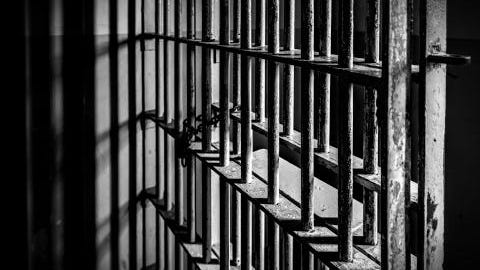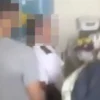Nina stared at the job listing. She felt as though it had been written just for her.
A new, multidisciplinary center for survivors of domestic violence was opening in northern San Diego County. The center needed bilingual care coordinators to talk with survivors of domestic violence and connect them with dozens of resources available through the center that could help them find safety, healing and independence.
It was the kind of help Nina wished she’d had over a decade ago when she found herself in a physically and emotionally abusive marriage. At the time, she was economically dependent on her husband, had limited education and job opportunities, and was afraid of calling the police because she was undocumented. She had no idea that support for domestic violence survivors exisited, or that she would qualify for help.
Now divorced, living independently with her two children, and with degrees in social sciences and criminal justice, Nina — who asked that only her first name be used for safety reasons — was ready to seize the opportunity to be the guiding light for other survivors that her old self so desparately needed.
“This is where I’m going,” she said, before applying and ultimately landing the care coordinator job. “This is where I need to be.”
The new center was called One Safe Place. Located in San Marcos, it’s one of 150 holistic centers for survivors of violence in the United States (26 of which are in California). The centers are designed to provide one-stop support for victims of domestic violence, sexual assault, elder abuse, child abuse and human trafficking. Known collectively as Family Justice Centers, they often include social workers, legal aid attorneys, medical staff and trained advocates like Nina who help with safety planning. Depending on the center, survivors can also get mental health support, groceries, housing assistance, job training, child care, youth mentoring, and access to the district attorney’s office or law enforcement personnel. One Safe Place even has a beauty salon and clothing boutique that offers new and gently used clothing.
” data-medium-file=”https://i0.wp.com/www.calhealthreport.org/wp-content/uploads/2023/11/Mike-Jump-Headshot-1.jpeg?fit=371%2C433&ssl=1″ data-large-file=”https://i0.wp.com/www.calhealthreport.org/wp-content/uploads/2023/11/Mike-Jump-Headshot-1.jpeg?fit=371%2C433&ssl=1″ decoding=”async” width=”371″ height=”433″ src=”https://i0.wp.com/www.calhealthreport.org/wp-content/uploads/2023/11/Mike-Jump-Headshot-1.jpeg?resize=371%2C433&ssl=1″ alt class=”wp-image-36050″ data-recalc-dims=”1″>
The goal is to make it easy for violence survivors and their children to get all of their needs taken care of in one place, and to spare them from having to visit multiple locations and retell their stories repeatedly — an especially difficult task for people facing adversity and trauma.
“You have this community that’s surrounding a victim, and it’s all in one place and its convenient,” said Michael Jump, executive director of the Ventura County Family Justice Center, and an executive committee member of the California Family Justice Network, an organization representing all the centers in the state.
“Without that, what you have is a system that is a bunch of silos and you’re asking somebody who’s going through some of the worst times in their lives and has a lot of decisions to make about their future to find their own way in accessing all these exisiting support services,” he continued. “The reality is it’s so overwhelming that the vast majority of those domestic violence victims will simply not follow thorugh, they’ll opt out.”
” data-medium-file=”https://i0.wp.com/www.calhealthreport.org/wp-content/uploads/2023/11/San-Diego_2.jpg?fit=600%2C400&ssl=1″ data-large-file=”https://i0.wp.com/www.calhealthreport.org/wp-content/uploads/2023/11/San-Diego_2.jpg?fit=1024%2C683&ssl=1″ decoding=”async” width=”1024″ height=”683″ src=”https://i0.wp.com/www.calhealthreport.org/wp-content/uploads/2023/11/San-Diego_2.jpg?resize=1024%2C683&ssl=1″ alt class=”wp-image-36046″ srcset=”https://i0.wp.com/www.calhealthreport.org/wp-content/uploads/2023/11/San-Diego_2.jpg?resize=1024%2C683&ssl=1 1024w, https://i0.wp.com/www.calhealthreport.org/wp-content/uploads/2023/11/San-Diego_2.jpg?resize=600%2C400&ssl=1 600w, https://i0.wp.com/www.calhealthreport.org/wp-content/uploads/2023/11/San-Diego_2.jpg?resize=768%2C512&ssl=1 768w, https://i0.wp.com/www.calhealthreport.org/wp-content/uploads/2023/11/San-Diego_2.jpg?resize=1536%2C1024&ssl=1 1536w, https://i0.wp.com/www.calhealthreport.org/wp-content/uploads/2023/11/San-Diego_2.jpg?resize=640%2C427&ssl=1 640w, https://i0.wp.com/www.calhealthreport.org/wp-content/uploads/2023/11/San-Diego_2.jpg?resize=1200%2C800&ssl=1 1200w, https://i0.wp.com/www.calhealthreport.org/wp-content/uploads/2023/11/San-Diego_2.jpg?w=2048&ssl=1 2048w” sizes=”(max-width: 639px) 98vw, (max-width: 1199px) 64vw, 770px” data-recalc-dims=”1″>
From crisis to long-term support
San Diego’s District Attorney Summer Stephan opened One Safe Place in July 2022. The 44,000-square-foot facility brings together almost 100 partner agencies, about half of which are located on site, making it one of the largest Family Justice Centers in the world. Since opening, the center has served more than 3,000 people, the majority of them domestic violence survivors who have children.
The center’s comprehensive, wraparound approach supports survivors in addressing both their immediate needs and moving them beyond that to establish a better life, said One Safe Place Executive Director Claudia Grasso. Often, people arrive at the center fresh from a crime scene or after a police domestic violence call and need urgent intervention. About half return to the center multiple times to get help as they move through their journey to healing and recovery, she said. Having access to supports that will help them over the long-term is key.
“We get people here showing up in crisis mode,” Grasso said. “We can help a victim of domestic violence come out of crisis mode, but if he or she does not have a way to basically support him or herself and their families, their likelihood of returning to an abuser is high.”
” data-medium-file=”https://i0.wp.com/www.calhealthreport.org/wp-content/uploads/2023/11/Susun-Kim.jpg?fit=193%2C402&ssl=1″ data-large-file=”https://i0.wp.com/www.calhealthreport.org/wp-content/uploads/2023/11/Susun-Kim.jpg?fit=193%2C402&ssl=1″ decoding=”async” width=”193″ height=”402″ src=”https://i0.wp.com/www.calhealthreport.org/wp-content/uploads/2023/11/Susun-Kim.jpg?resize=193%2C402&ssl=1″ alt class=”wp-image-36051″ data-recalc-dims=”1″>
To build trust and reduce fear among survivors, Family Justice Centers do not require people to show documentation when they visit. No one is pressured to take legal action against the person who harmed them or report to police. People are not required to disclose their immigration status, and those who are undocumented are not reported to immigration authorities. In fact, many centers offer legal services to help with immigration issues. A principle of the centers is that the support provided is survivor-driven, meaning that it’s tailored to what the survivors themselves say they need.
Evaluations of Family Justice Centers offer compelling evidence that the model significantly increases the safety of survivors and reduces homicides. Women are more likely to be killed by an intimate partner than anyone else. Research shows that after visiting the centers, survivors have less anxiety and are more hopeful for their futures. The U.S. Department of Justice has identified the Family Justice Center model as a best practice in the field of domestic violence intervention and prevention services.
Nevertheless, fewer than half of California’s 58 counties have a Family Justice Center, and there is no permanent source of state funding for the centers. Susun Kim, executive director of four family justice centers across Solano and Contra Costa counties and a leader within the California Family Justice Network, said she believes many more California counties could benefit from the model. Her network is pushing for the state to establish a permanent funding source, and offers guidance to communities interested in setting up their own family justice centers.
“I know what you’re going through”
” data-medium-file=”https://i0.wp.com/www.calhealthreport.org/wp-content/uploads/2023/11/Nina-scaled.jpg?fit=400%2C600&ssl=1″ data-large-file=”https://i0.wp.com/www.calhealthreport.org/wp-content/uploads/2023/11/Nina-scaled.jpg?fit=683%2C1024&ssl=1″ decoding=”async” loading=”lazy” width=”683″ height=”1024″ src=”https://i0.wp.com/www.calhealthreport.org/wp-content/uploads/2023/11/Nina.jpg?resize=683%2C1024&ssl=1″ alt class=”wp-image-36043″ srcset=”https://i0.wp.com/www.calhealthreport.org/wp-content/uploads/2023/11/Nina-scaled.jpg?resize=683%2C1024&ssl=1 683w, https://i0.wp.com/www.calhealthreport.org/wp-content/uploads/2023/11/Nina-scaled.jpg?resize=400%2C600&ssl=1 400w, https://i0.wp.com/www.calhealthreport.org/wp-content/uploads/2023/11/Nina-scaled.jpg?resize=768%2C1152&ssl=1 768w, https://i0.wp.com/www.calhealthreport.org/wp-content/uploads/2023/11/Nina-scaled.jpg?resize=1024%2C1536&ssl=1 1024w, https://i0.wp.com/www.calhealthreport.org/wp-content/uploads/2023/11/Nina-scaled.jpg?resize=1365%2C2048&ssl=1 1365w, https://i0.wp.com/www.calhealthreport.org/wp-content/uploads/2023/11/Nina-scaled.jpg?resize=640%2C960&ssl=1 640w, https://i0.wp.com/www.calhealthreport.org/wp-content/uploads/2023/11/Nina-scaled.jpg?resize=1200%2C1800&ssl=1 1200w, https://i0.wp.com/www.calhealthreport.org/wp-content/uploads/2023/11/Nina-scaled.jpg?w=1707&ssl=1 1707w” sizes=”(max-width: 639px) 98vw, (max-width: 1199px) 64vw, 683px” data-recalc-dims=”1″>
Nina began working at One Safe Place when the center opened in July. She talks with survivors over the phone and when they walk through the door. She listens intently to assess their situations, helps them understand their options, and connects them to the resources they need and want — often simply walking them over to other organizations and people in the building that can help them.
Many of the fears and obstacles the survivors point to are the same ones Nina faced when she was in her previous relationship. In addition to her lack of knowledge about support available and fear about being undocumented, her husband persuaded her that the violence was her fault. What’s more, she didn’t want to admit to herself that the person whom she thought loved her was harming her.
“I had that same mentality,” she said. “There was always an excuse: well, ‘Christmas is coming and how can I do this to my kids?’ Or, ‘Their birthday is coming, why would I want my kids to not have a dad for their birthday?’”
On a recent day, she talked to a woman who called in at the suggestion of police after they responded to a violent incident at her home. The woman tried to downplay her husband’s abuse, insisting that he wasn’t violent because he hadn’t hit her in a month, and had only shoved her against a wall.
Patiently, Nina explained that shoving against a wall is physical violence. She urged the woman to come to One Safe Place. When the woman came in, Nina was able to get her into a domestic violence shelter and set her up with trauma therapy. Nina said that once the woman realized she could get support, she decided not to return to her husband. She’s now going to therapy and working on finding employment and getting her own apartment.
“Working here is so rewarding for me,” Nina said. “I’ve lived that side of where (the survivors) are standing at that moment and I can honestly say, ‘I understand, I know what you’re going through.’”
” data-medium-file=”https://i0.wp.com/www.calhealthreport.org/wp-content/uploads/2023/11/Ventura-County-FJC_lobby-create-space.jpg?fit=502%2C521&ssl=1″ data-large-file=”https://i0.wp.com/www.calhealthreport.org/wp-content/uploads/2023/11/Ventura-County-FJC_lobby-create-space.jpg?fit=502%2C521&ssl=1″ decoding=”async” loading=”lazy” width=”502″ height=”521″ src=”https://i0.wp.com/www.calhealthreport.org/wp-content/uploads/2023/11/Ventura-County-FJC_lobby-create-space.jpg?resize=502%2C521&ssl=1″ alt class=”wp-image-36047″ data-recalc-dims=”1″>
Making the system work for survivors
The first Family Justice Center opened in 2002, when then-San Diego City Attorney Casey Gwinn and former Police Chief David Bejarano launched Your Safe Place in downtown San Diego. The center’s creation sparked a national movement. In 2003, President George W. Bush announced the creation of a $20 million Family Justice Center Initiative, based on the San Diego model.
Kim said she was skeptical of the Family Justice Center model when she first heard about it in 2009. At the time, she was managing attorney for Bay Area Legal Aid and believed her agency was already doing enough to help survivors by successfully assisting them in getting restraing orders. But after Contra Costa County opened a pilot family justice center one day a week, she quickly realized survivors were hungry for additional support. Within a year, the center had to open five days a week to keep up with demand.
Survivors “needed food, they needed money, transportation, mental health, someone to talk to, someone to go to court for them, so much more than the piece of paper I was able to get,” said Kim, who took the helm of the Contra Costa Family Justice Center in 2014. “Your typical domestic violence organization is one organization trying to do everthing. But it’s really difficult for you to learn every system.”
The need to offer more comprehensive support to domestic violence survivors is one reason Stephan prioritized opening One Safe Place after she became district attorney in 2018. She wanted survivors in northern San Diego County to have access to the same support availabilt within the city of San Diego. And she was eager to move beyond what the justice system alone could offer and address intergenerational cycles of violence. During her decades-long career as a prosecutor, she’d seen survivors and their family members cycle through the legal system but wind up back in abusive situations. Children who witnessed domestic violence engaged in violence themselves or were victims of it. Something was missing.
“We prosecuted these cases successfully, brought justice, but I was always left at the end of what should feel like a win with this feeling in my stomach of, ‘What happens next for the victims?’” Stephan said. “‘How do we help them continue their journey into real health, real liberty, real freedom from abuse, if they’re so tied economically and emotionally to the abuser?’”
Nina shudders when she considers what could have happened to her own children if she had remained in an abusive relationship. Her husband eventually left her — she believes because she got a job and become more financially independent and stopped being afraid of him. One of her children recently disclosed to Nina that, growing up, they thought abusive behavior was normal in a marriage. She now shares this with her clients. One Safe Place provides therapy and mentorship programs for children who have witnessed or experienced abuse.
“As victims we think, ‘Well, I was protecting my kids. They didn’t see anything,’” Nina said. “Even if they don’t see it, they hear it.”
” data-medium-file=”https://i0.wp.com/www.calhealthreport.org/wp-content/uploads/2023/11/San-Diego_1cropped.jpeg?fit=600%2C409&ssl=1″ data-large-file=”https://i0.wp.com/www.calhealthreport.org/wp-content/uploads/2023/11/San-Diego_1cropped.jpeg?fit=1024%2C697&ssl=1″ decoding=”async” loading=”lazy” width=”1024″ height=”697″ src=”https://i0.wp.com/www.calhealthreport.org/wp-content/uploads/2023/11/San-Diego_1cropped.jpeg?resize=1024%2C697&ssl=1″ alt class=”wp-image-36038″ srcset=”https://i0.wp.com/www.calhealthreport.org/wp-content/uploads/2023/11/San-Diego_1cropped.jpeg?resize=1024%2C697&ssl=1 1024w, https://i0.wp.com/www.calhealthreport.org/wp-content/uploads/2023/11/San-Diego_1cropped.jpeg?resize=600%2C409&ssl=1 600w, https://i0.wp.com/www.calhealthreport.org/wp-content/uploads/2023/11/San-Diego_1cropped.jpeg?resize=768%2C523&ssl=1 768w, https://i0.wp.com/www.calhealthreport.org/wp-content/uploads/2023/11/San-Diego_1cropped.jpeg?resize=640%2C436&ssl=1 640w, https://i0.wp.com/www.calhealthreport.org/wp-content/uploads/2023/11/San-Diego_1cropped.jpeg?resize=1200%2C817&ssl=1 1200w, https://i0.wp.com/www.calhealthreport.org/wp-content/uploads/2023/11/San-Diego_1cropped.jpeg?w=1244&ssl=1 1244w” sizes=”(max-width: 639px) 98vw, (max-width: 1199px) 64vw, 770px” data-recalc-dims=”1″>
Overcoming mistrust
Some Family Justice Centers have law enforcement personnel on site, or are located close to district attorney or other government agency offices. This arrangement can make some community members nervous about seeking help because they’ve had negative past experiences with police or are fearful because of their immigration status, said Erin Scott, executive director of the Family Violence Law Center. Her organization provides crisis intervention services at the Alameda County Family Justice Center, mainly to survivors of color. The center has a sheriff’s deputy on site to provide security, and shares a building with the Oakland police and district attorney’s office. Because of this, one local community organization serving indigenous migrants won’t send clients there, Scott said.
“Having any law enfocement presence is not comfortable for some people,” Scott said. “We haven’t had a lot of explicit complaints from clients, but we have had (the issue) raised by community partners in terms of referring their clients to come to the building.”
Kim said Family Justice Centers are well aware of the mistrust toward law enforcement in some communities, especially since the death of George Floyd and subsequent protests. A majority of survivors served by the centers are women of color (about 15 percent of clients are men). That’s why the centers do not require survivors to report abuse to law enforcement (an exception is in cases of suspected child abuse, which center staff are mandated to report, said Jump).
In many counties, law enforcement officials play an active role in refering survivors to the centers, which Kim believes helps build trust because survivors see police as actively helping them. Some centers, including One Safe Place, also have outreach workers who visit churches, schools and other community locations to talk about intimate partner violence and the services available, and to reassure community members that it is safe to seek help, even if they are undocumented.
” data-medium-file=”https://i0.wp.com/www.calhealthreport.org/wp-content/uploads/2023/11/Contra-Costa-Outreach-Event-scaled.jpg?fit=600%2C429&ssl=1″ data-large-file=”https://i0.wp.com/www.calhealthreport.org/wp-content/uploads/2023/11/Contra-Costa-Outreach-Event-scaled.jpg?fit=1024%2C731&ssl=1″ decoding=”async” loading=”lazy” width=”1024″ height=”731″ src=”https://i0.wp.com/www.calhealthreport.org/wp-content/uploads/2023/11/Contra-Costa-Outreach-Event-1024×731.jpg?resize=1024%2C731&ssl=1″ alt class=”wp-image-36048″ srcset=”https://i0.wp.com/www.calhealthreport.org/wp-content/uploads/2023/11/Contra-Costa-Outreach-Event-scaled.jpg?resize=1024%2C731&ssl=1 1024w, https://i0.wp.com/www.calhealthreport.org/wp-content/uploads/2023/11/Contra-Costa-Outreach-Event-scaled.jpg?resize=600%2C429&ssl=1 600w, https://i0.wp.com/www.calhealthreport.org/wp-content/uploads/2023/11/Contra-Costa-Outreach-Event-scaled.jpg?resize=768%2C549&ssl=1 768w, https://i0.wp.com/www.calhealthreport.org/wp-content/uploads/2023/11/Contra-Costa-Outreach-Event-scaled.jpg?resize=1536%2C1097&ssl=1 1536w, https://i0.wp.com/www.calhealthreport.org/wp-content/uploads/2023/11/Contra-Costa-Outreach-Event-scaled.jpg?resize=2048%2C1463&ssl=1 2048w, https://i0.wp.com/www.calhealthreport.org/wp-content/uploads/2023/11/Contra-Costa-Outreach-Event-scaled.jpg?resize=640%2C457&ssl=1 640w, https://i0.wp.com/www.calhealthreport.org/wp-content/uploads/2023/11/Contra-Costa-Outreach-Event-scaled.jpg?resize=1200%2C857&ssl=1 1200w” sizes=”(max-width: 639px) 98vw, (max-width: 1199px) 64vw, 770px” data-recalc-dims=”1″>
Expansion plans
While many California counties still don’t have Family Justice Centers, others are working quickly to open more. Stephan wants to open at least two more centers in San Diego County. Ventura County plans to open a second Family Justice Center in Oxnard next year, and another in East Ventura County in 2025. Riverside, Contra Costa and Santa Clara counties already have multiple centers.
Stephan said it can take time and a lot of persuasion to get local government officials behind preventive efforts like Family Justice Centers, but they ultimately save communities money by stemming generational cycles of violence, and they better serve the families and children who need help. Funding usually comes from a combination of grants, local government funds, and the resources partner agencies bring to the table. One Safe Place for example is funded through money from a local ballot initiative, and service providers bring their own funding.
“I do think that the Family Justice Center is a real beacon of hope and a real way to provide innovation that can impact lives and impact future generations,” Stephan said.
For Nina, helping other survivors feels like her life’s calling. It’s also a triumph. She remembers how her old self used to believe the hurtful words thrown at her: That she would never amount to anything, that she didn’t need a job or an education, that her English was bad, that no one would believe her if she told them about the abuse. Today she is fluent in English and holds two associate’s degrees and a bachelor’s degree in criminal justice from San Diego State University. Almost everyday, she shares her story.
“I am good enough to do this and being able to tell victims that come through our doors that they are good enough and actually believing that (about) myself, that’s a game changer,” she said. “Truly, honestly, I am doing a job that I love.”
Domestic Violence support:
To find your nearest family justice center, visit https://www.familyjusticecenter.org/affiliated-centers/family-justice-centers/
If you or someone you know is experiencing domestic violence, you can also contact the National Domestic Violence Hotline at 1-800-799-7233 for support and referrals, or text “START” to 88788. Information on local domestic violence programs can be found using this online tool.
For Native Americans and Alaska Natives, the StrongHearts Native Helpline at 1-844-7NATIVE (762-8483) provides 24/7 confidential and culturally appropriate support and advocacy for survivors of domestic and sexual violence. A chat option is available through their website.
This post was originally published on this site be sure to check out more of their content.










